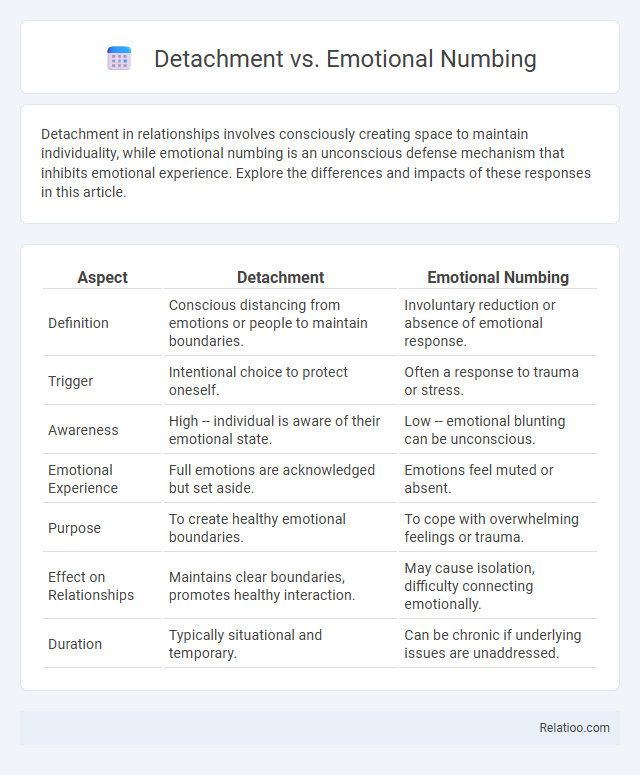Detachment in relationships involves consciously creating space to maintain individuality, while emotional numbing is an unconscious defense mechanism that inhibits emotional experience. Explore the differences and impacts of these responses in this article.
Table of Comparison
| Aspect | Detachment | Emotional Numbing |
|---|---|---|
| Definition | Conscious distancing from emotions or people to maintain boundaries. | Involuntary reduction or absence of emotional response. |
| Trigger | Intentional choice to protect oneself. | Often a response to trauma or stress. |
| Awareness | High -- individual is aware of their emotional state. | Low -- emotional blunting can be unconscious. |
| Emotional Experience | Full emotions are acknowledged but set aside. | Emotions feel muted or absent. |
| Purpose | To create healthy emotional boundaries. | To cope with overwhelming feelings or trauma. |
| Effect on Relationships | Maintains clear boundaries, promotes healthy interaction. | May cause isolation, difficulty connecting emotionally. |
| Duration | Typically situational and temporary. | Can be chronic if underlying issues are unaddressed. |
Understanding Detachment: A Healthy Boundary
Understanding detachment involves recognizing it as a healthy boundary that allows You to maintain emotional balance without becoming overwhelmed by others' feelings or situations. Unlike emotional numbing, which dulls all feelings and can lead to disengagement, detachment promotes clear awareness and purposeful emotional regulation. This conscious separation helps preserve Your mental well-being while fostering compassionate relationships.
What is Emotional Numbing?
Emotional numbing is a psychological response characterized by a significant reduction in the ability to feel emotions, often as a defense mechanism against trauma or stress. Unlike detachment, which involves feeling disconnected from one's surroundings or relationships, emotional numbing specifically refers to an internal shutdown of emotional experiences. This condition is commonly observed in individuals with post-traumatic stress disorder (PTSD), depression, and anxiety, where the blunted affect impacts emotional responsiveness and relationships.
Key Differences Between Detachment and Emotional Numbing
Detachment involves a conscious choice to distance oneself emotionally from a situation, often as a coping mechanism, while emotional numbing refers to an involuntary blunting of emotional responses, commonly linked to trauma or depression. Detachment enables clear decision-making by maintaining cognitive control, whereas emotional numbing results in diminished affect, reducing both positive and negative emotions. Key differences lie in awareness and control: detachment is intentional and selective, emotional numbing is automatic and pervasive.
Causes of Emotional Numbing
Emotional numbing often arises from prolonged exposure to trauma, chronic stress, or unresolved psychological conflicts, leading to a diminished capacity to experience emotions fully. It differs from detachment, which can be a conscious coping mechanism where You distance Yourself from emotional pain, whereas numbing is an automatic, subconscious response. Understanding these causes is crucial for addressing emotional numbness effectively and restoring emotional balance.
Benefits of Healthy Detachment
Healthy detachment allows you to maintain emotional balance and clarity, enabling objective decision-making without being overwhelmed by stress or anxiety. Unlike emotional numbing, which dulls all feelings and can lead to disconnection and depression, healthy detachment preserves empathy and self-awareness. Practicing this mindful separation fosters resilience, improves relationships, and supports mental well-being by helping you navigate challenges with calm and composure.
Signs You Might Be Emotionally Numb
Signs you might be emotionally numb include a persistent inability to feel joy, sadness, or anger, often resulting in a sense of detachment from your surroundings and relationships. You may experience a lack of emotional response even in situations that typically provoke strong feelings, combined with a tendency to avoid intimacy and vulnerability. This emotional numbness contrasts with detachment, which can be a conscious coping mechanism, as numbness often reflects an unconscious shutdown of emotional processing.
Psychological Impacts of Chronic Numbing
Chronic numbing leads to significant psychological impacts including impaired emotional regulation, reduced empathy, and increased risk for depression and anxiety disorders, as it disrupts natural affective processing. Detachment, often a conscious coping mechanism to distance oneself from traumatic experiences, contrasts with emotional numbing, which is an involuntary shutdown of feelings that limits personal connection and social support. Prolonged exposure to emotional numbing can result in diminished self-awareness and exacerbate symptoms of post-traumatic stress disorder (PTSD), complicating recovery and impairing overall mental health.
Cultivating Mindful Detachment
Cultivating mindful detachment involves consciously observing thoughts and emotions without becoming overwhelmed or disconnected, allowing for emotional clarity and resilience. Unlike emotional numbing, which suppresses feelings to avoid pain, mindful detachment promotes awareness and acceptance of emotions without judgment. This practice enhances emotional regulation and supports mental well-being by fostering a balanced engagement with experiences.
Healing From Emotional Numbing
Healing from emotional numbing involves recognizing the differences between detachment and emotional numbing, where detachment serves as a healthy coping mechanism, while emotional numbing represents a deeper disconnection from feelings. Your recovery process benefits from therapeutic approaches that encourage emotional awareness and gradual re-engagement with emotions, restoring your ability to experience and process feelings fully. Addressing underlying trauma and practicing mindfulness techniques enhance emotional resilience, enabling sustained healing beyond mere detachment.
When to Seek Professional Help
Emotional detachment, emotional numbing, and general detachment can significantly impact your mental health and daily functioning when persistent or severe. Seek professional help if you notice prolonged inability to connect emotionally, feelings of emptiness, or if these symptoms interfere with relationships and work performance. Early intervention by a mental health professional can provide tailored strategies to restore emotional balance and improve overall well-being.

Infographic: Detachment vs Emotional Numbing
 relatioo.com
relatioo.com